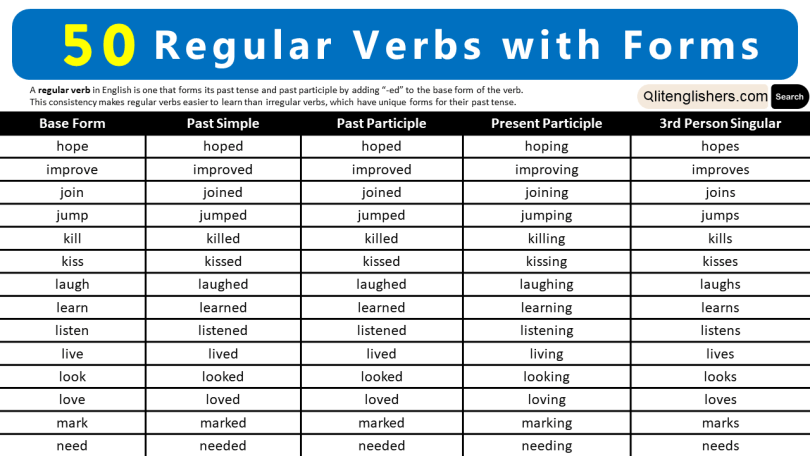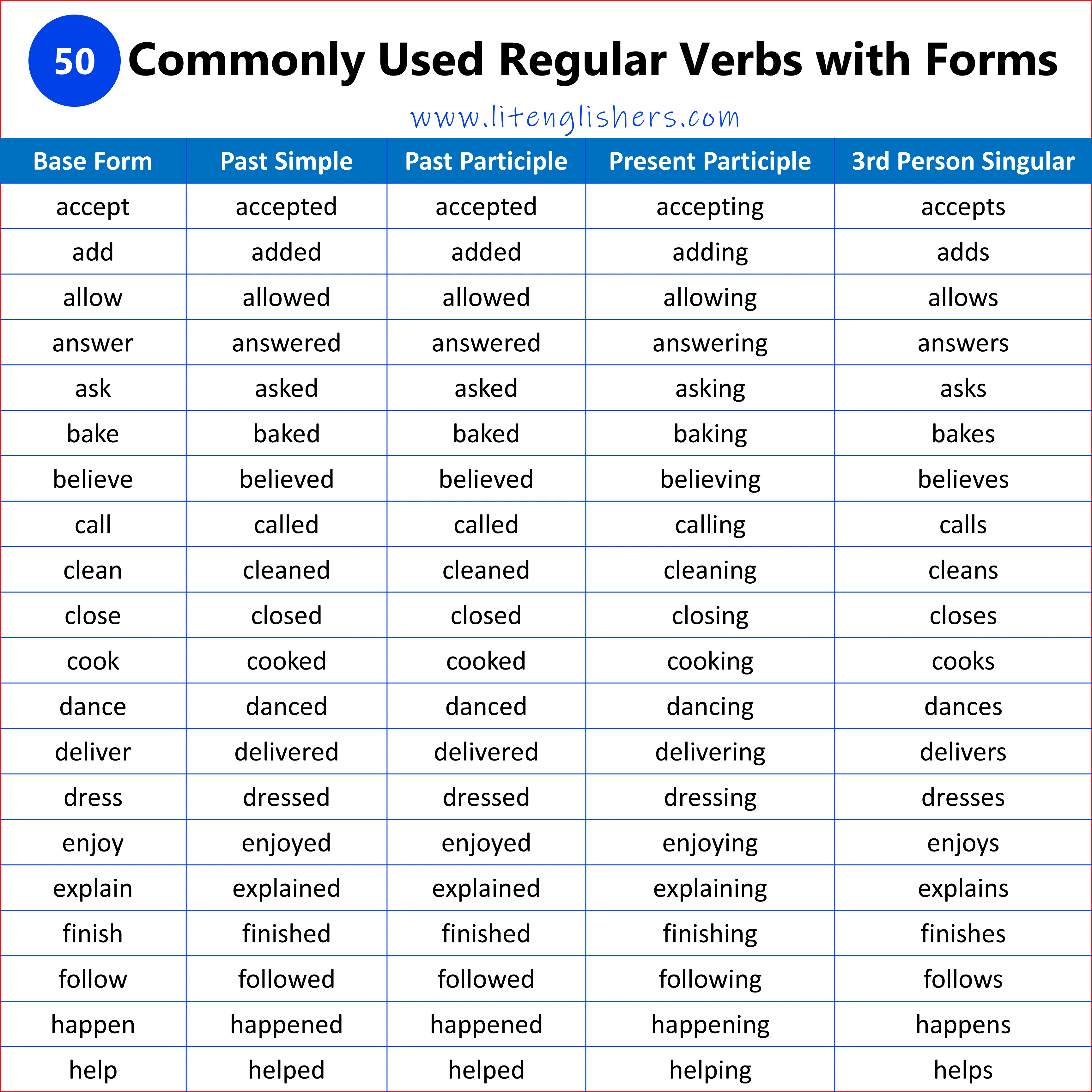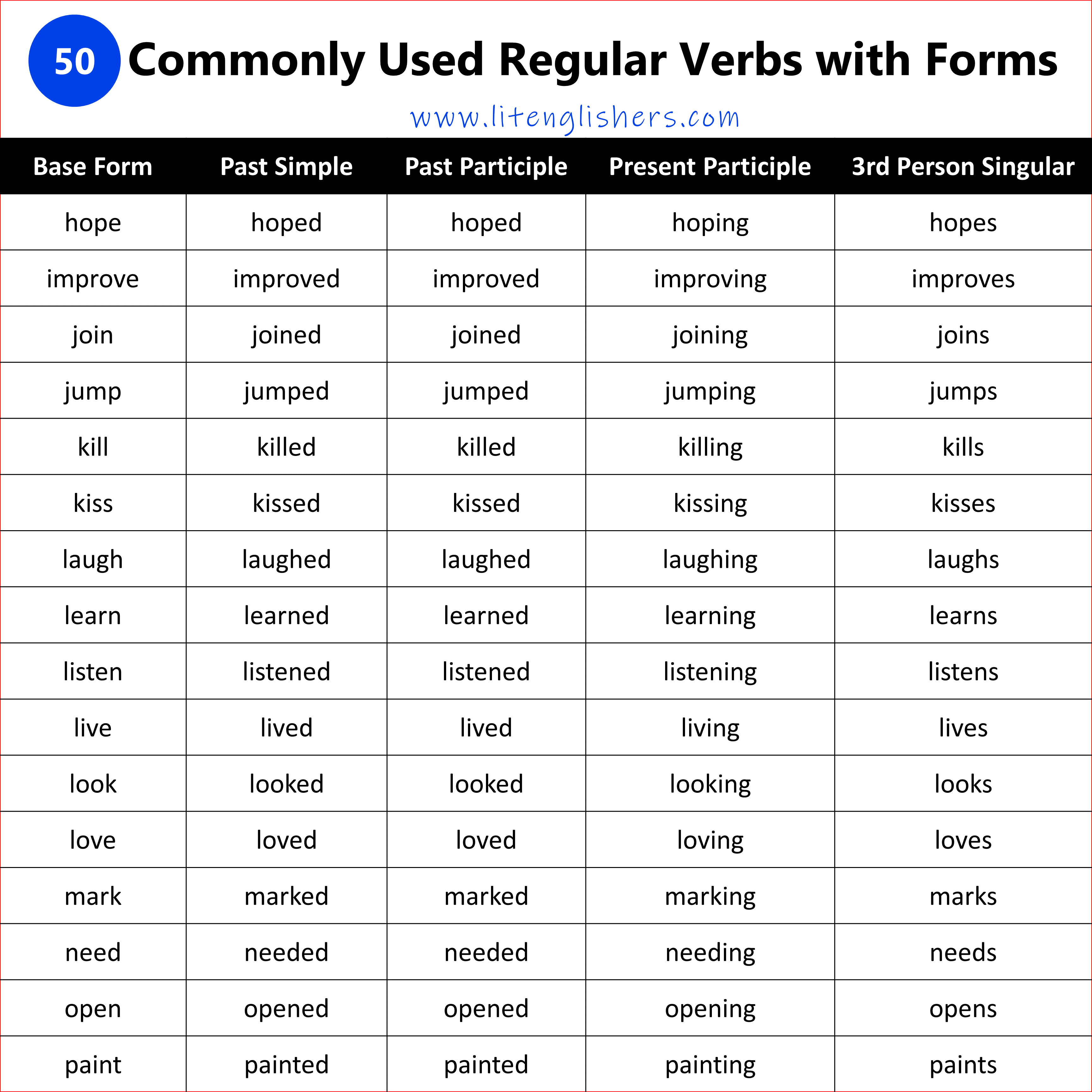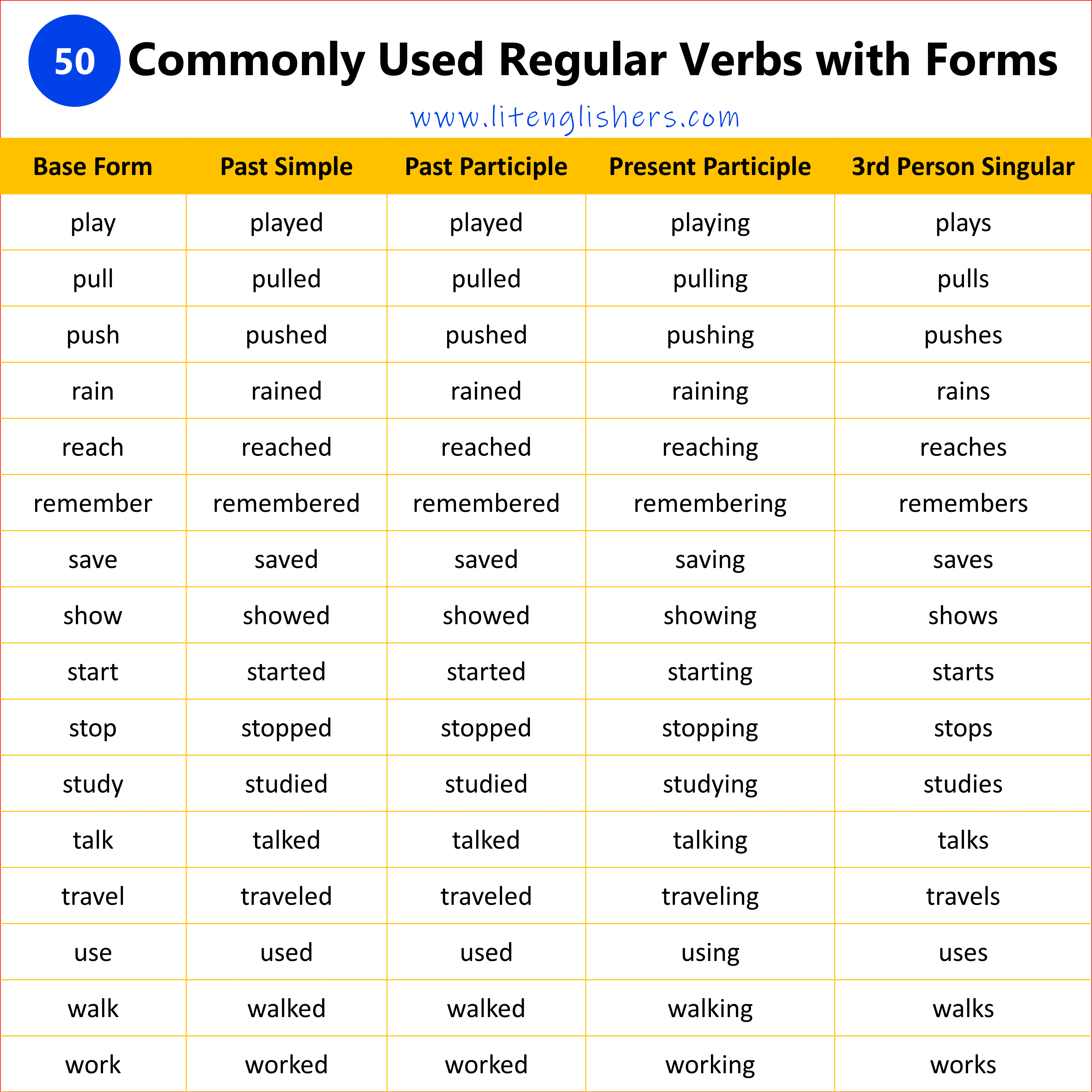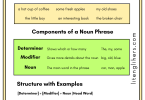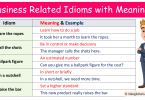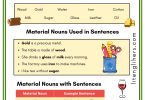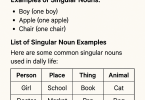Learning regular verbs with their five forms (base form, past simple, past participle, present participle, and 3rd person singular) has several benefits, especially for learners of English. In this lesson, I am going to share with you the 50 most commonly used regular verbs with their five forms in English. We use these verbs in our everyday conversation, and we also need to understand how we can use them in sentences.
In this section, we will study the definition, usage, and benefits of learning the regular verbs with their five forms in English. So, without further ado, let’s begin with today’s lesson:
Definition of Regular Verbs
A regular verb is a verb in English that follows a predictable pattern when forming its past tense and past participle. These forms are created by adding -ed or -d to the base form of the verb. Regular verbs do not undergo significant changes in their spelling when conjugated.
Learn More: Regular Verbs in English
Characteristics of Regular Verbs:
- Consistent Pattern for Past Forms
- Base Form → Add -ed (or -d if the verb ends in e).
- Examples:
- Base Form: walk → Past Tense: walked → Past Participle: walked
- Base Form: love → Past Tense: loved → Past Participle: loved
- No Irregular Changes in Spelling or Sound
- Unlike irregular verbs, regular verbs don’t change their internal structure (e.g., “run” → “ran”).
- Present Participle
- Regular verbs follow the same rule for forming the present participle (add -ing).
- Example: walk → walking, talk → talking
- 3rd Person Singular
- In the present tense, add -s or -es for the 3rd person singular form.
- Example:
- He walks, she talks, and it rains.
Examples of Regular Verbs:
| Base Form | Past Tense | Past Participle |
|---|---|---|
| Play | Played | Played |
| Work | Worked | Worked |
| Call | Called | Called |
| Wash | Washed | Washed |
Benefits of Learning Regular Verbs
1. Foundation for Sentence Construction
- Knowing the forms allows you to construct sentences correctly in different tenses and aspects, such as:
- Present Simple: She walks every morning.
- Past Simple: He walked yesterday.
- Present Perfect: They have walked to the park.
2. Improves Fluency in Writing and Speaking
- Learning the forms helps avoid common grammatical errors and makes communication smoother. For example:
- Incorrect: He walk to school yesterday.
- Correct: He walked to school yesterday.
3. Enhances Understanding of English Grammar
- Mastering regular verb forms deepens your understanding of verb conjugation, which is essential for learning irregular verbs, auxiliary verbs, and modal verbs.
4. Facilitates Effective Communication
- Using the correct verb forms ensures clarity and accuracy in expressing time and continuity. For example:
- I am walking to the store (action in progress).
- I walked to the store (action completed).
5. Builds Confidence in Using English
- Memorizing and practicing the five forms instills confidence, reducing hesitation and mistakes when speaking or writing.
6. Supports Exam Preparation
- Knowledge of verb forms is essential for exams like TOEFL, IELTS, or any English proficiency test, where you may need to recognize or produce correct verb forms.
7. Foundation for Learning Advanced Grammar
- Understanding these forms is a stepping stone to mastering advanced grammatical structures like the passive voice, conditionals, or reported speech. For example:
- Passive voice: “The book was read by her.”
- Conditionals: “If he had studied, he would have passed.”
8. Makes Vocabulary Learning Systematic
- Regular verbs follow predictable patterns, which makes them easier to learn and apply compared to irregular verbs. This provides a structured way to expand your vocabulary.
Now, we will learn the 50 most commonly used regular verbs with their five forms (base form, past simple, past participle, present participle, and 3rd person singular) in English.
| Base Form | Past Simple | Past Participle | Present Participle | 3rd Person Singular |
|---|---|---|---|---|
| accept | accepted | accepted | accepting | accepts |
| add | added | added | adding | adds |
| allow | allowed | allowed | allowing | allows |
| answer | answered | answered | answering | answers |
| ask | asked | asked | asking | asks |
| bake | baked | baked | baking | bakes |
| believe | believed | believed | believing | believes |
| call | called | called | calling | calls |
| clean | cleaned | cleaned | cleaning | cleans |
| close | closed | closed | closing | closes |
| cook | cooked | cooked | cooking | cooks |
| dance | danced | danced | dancing | dances |
| deliver | delivered | delivered | delivering | delivers |
| dress | dressed | dressed | dressing | dresses |
| enjoy | enjoyed | enjoyed | enjoying | enjoys |
| explain | explained | explained | explaining | explains |
| finish | finished | finished | finishing | finishes |
| follow | followed | followed | following | follows |
| happen | happened | happened | happening | happens |
| help | helped | helped | helping | helps |
| hope | hoped | hoped | hoping | hopes |
| improve | improved | improved | improving | improves |
| join | joined | joined | joining | joins |
| jump | jumped | jumped | jumping | jumps |
| kill | killed | killed | killing | kills |
| kiss | kissed | kissed | kissing | kisses |
| laugh | laughed | laughed | laughing | laughs |
| learn | learned | learned | learning | learns |
| listen | listened | listened | listening | listens |
| live | lived | lived | living | lives |
| look | looked | looked | looking | looks |
| love | loved | loved | loving | loves |
| mark | marked | marked | marking | marks |
| need | needed | needed | needing | needs |
| open | opened | opened | opening | opens |
| paint | painted | painted | painting | paints |
| play | played | played | playing | plays |
| pull | pulled | pulled | pulling | pulls |
| push | pushed | pushed | pushing | pushes |
| rain | rained | rained | raining | rains |
| reach | reached | reached | reaching | reaches |
| remember | remembered | remembered | remembering | remembers |
| save | saved | saved | saving | saves |
| show | showed | showed | showing | shows |
| start | started | started | starting | starts |
| stop | stopped | stopped | stopping | stops |
| study | studied | studied | studying | studies |
| talk | talked | talked | talking | talks |
| travel | traveled | traveled | traveling | travels |
| use | used | used | using | uses |
| walk | walked | walked | walking | walks |
| work | worked | worked | working | works |
Understanding regular verbs helps English learners because they follow predictable rules, making them easier to learn compared to irregular verbs, which can have unique conjugation patterns.
The PDF book of this lesson is given below; you can download it with one click.
Learn More:
